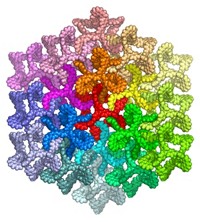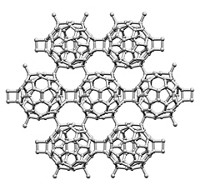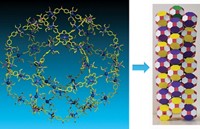Advertisement
Grab your lab coat. Let's get started
Welcome!
Welcome!
Create an account below to get 6 C&EN articles per month, receive newsletters and more - all free.
It seems this is your first time logging in online. Please enter the following information to continue.
As an ACS member you automatically get access to this site. All we need is few more details to create your reading experience.
Not you? Sign in with a different account.
Not you? Sign in with a different account.
ERROR 1
ERROR 1
ERROR 2
ERROR 2
ERROR 2
ERROR 2
ERROR 2
Password and Confirm password must match.
If you have an ACS member number, please enter it here so we can link this account to your membership. (optional)
ERROR 2
ACS values your privacy. By submitting your information, you are gaining access to C&EN and subscribing to our weekly newsletter. We use the information you provide to make your reading experience better, and we will never sell your data to third party members.
Materials
Cage Keeps C60 Captive In The Solid State
Molecular cage captures fullerene guests, even in the absence of solvent
by Bethany Halford
July 26, 2010
| A version of this story appeared in
Volume 88, Issue 30

Molecular cages can be the rudest of hosts. Guests are welcome as long as there’s plenty of solvent around, but removing the cages from solution and close packing keeps visitors out. Now, chemists in Japan have created a molecular cage capable of capturing fullerene guests, even in the solid state (Nat. Chem., DOI: 10.1038/nchem.742). The University of Tokyo’s Makoto Fujita, Yasuhide Inokuma, and Tatsuhiko Arai created a “crystalline molecular sponge” from a network of octahedral M6L4 cages, where the metal complex M is Co(NCS)2 and the ligand L is 2,4,6-tris(4-pyridyl)-1,3,5-triazine. The material has three distinct cage structures, possessing vast interstitial voids with the cuboctahedral cage structures M12L8 and M12L24, which are capable of capturing C60 and larger fullerenes. When crystals of the molecular cage were soaked in a saturated toluene solution of C60, they absorbed an impressive 35% of the material’s weight in the fullerene, gradually turning black in the process. Furthermore, when the crystals were placed in a solution that was equal parts C60 and C70, the material preferentially absorbed the larger fullerene, which, according to the authors, could lead to new methods for enrichment and isolation.





Join the conversation
Contact the reporter
Submit a Letter to the Editor for publication
Engage with us on Twitter